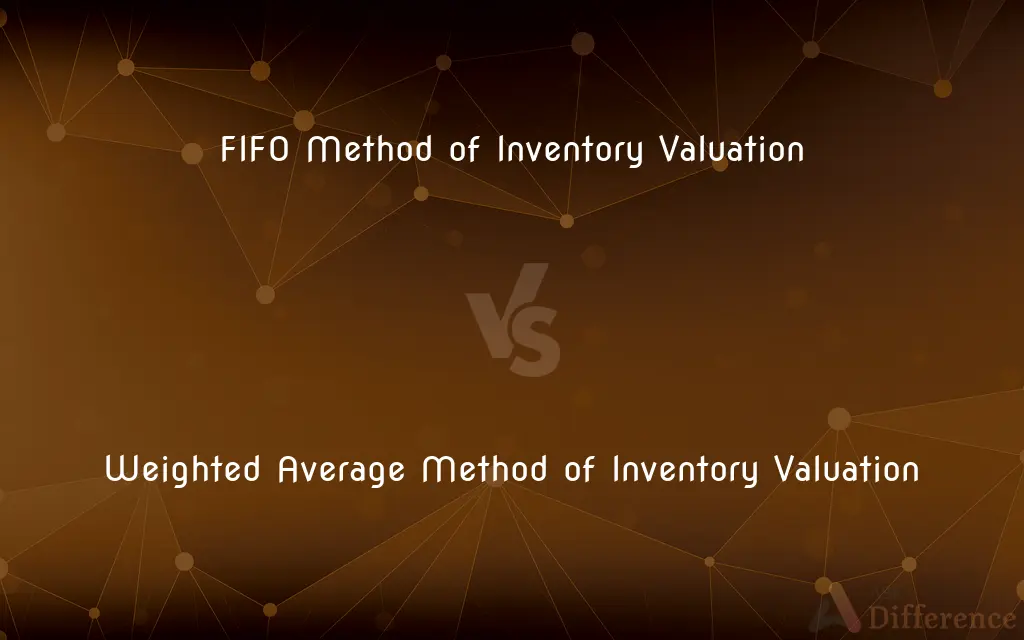FIFO Method of Inventory Valuation vs. Weighted Average Method of Inventory Valuation — What's the Difference?
By Tayyaba Rehman — Published on January 18, 2024
FIFO (First-In, First-Out) method assumes the oldest inventory is sold first, while the Weighted Average method calculates an average cost for all inventory items and applies it to the cost of goods sold.

Difference Between FIFO Method of Inventory Valuation and Weighted Average Method of Inventory Valuation
Table of Contents
ADVERTISEMENT
Key Differences
Inventory Cost Assumption: FIFO method assumes that the first items purchased are the first sold, reflecting the actual flow of goods. The Weighted Average method averages the cost of all inventory items and applies this average to determine the cost of goods sold.
Impact of Price Fluctuations: In a period of rising prices, FIFO results in lower cost of goods sold and higher reported profits, as older, cheaper goods are sold first. The Weighted Average method smooths out price variations, leading to more stable cost of goods sold and profit figures.
Complexity and Calculation: FIFO is straightforward in principle but can be complex in practice with large inventory levels. The Weighted Average method requires continuous calculation of the average cost, which can be complex but provides a more uniform cost per unit.
Tax and Reporting Implications: Under FIFO, in inflationary periods, lower COGS can lead to higher taxes due to higher profits. The Weighted Average method may result in moderate tax liabilities since profit reporting is more leveled.
Usage and Preference: FIFO is preferred in industries where inventory products are perishable or subject to obsolescence. The Weighted Average method is often used in industries with large quantities of similar items and less concern about stock rotation.
ADVERTISEMENT
Comparison Chart
Cost Assumption
First purchased items sold first
Average cost for all items
Price Fluctuation Impact
Higher impact on profit and COGS
Smooths out price fluctuations
Complexity
Simple in theory, complex with large inventory
Continuous average cost calculation needed
Tax Implications
Possibly higher taxes in inflationary periods
More moderate impact on taxes
Preferred Usage
Perishable goods, items with obsolescence
Industries with large, similar inventory
Compare with Definitions
FIFO Method of Inventory Valuation
Reflects Physical Flow: Mimics the actual flow of goods.
FIFO works well for our perishable products as it matches their actual usage.
Weighted Average Method of Inventory Valuation
Suitable for Similar Items: Ideal for similar, non-perishable items.
For our bulk hardware supplies, we use the weighted average method.
FIFO Method of Inventory Valuation
Inventory Cost Tracking: Tracks costs based on purchase order.
Our FIFO system helps track costs accurately for each batch.
Weighted Average Method of Inventory Valuation
Moderate Tax Impact: Results in moderate profit and tax reporting.
Our taxable income is more stable year-over-year with the weighted average.
FIFO Method of Inventory Valuation
Tax Implications: Can lead to higher taxes in inflation.
Our taxable income is higher this year due to the FIFO valuation method.
Weighted Average Method of Inventory Valuation
Average Cost Calculation: Calculates an average cost for inventory.
Our cost of goods sold is based on the weighted average cost of all stock.
FIFO Method of Inventory Valuation
Higher Profit in Inflation: Shows higher profit in times of rising costs.
With rising material costs, FIFO shows better profitability.
Weighted Average Method of Inventory Valuation
Uniform Cost Application: Applies a uniform cost per unit.
Each unit sold has the same cost under the weighted average method.
FIFO Method of Inventory Valuation
Oldest Inventory First: Assumes oldest inventory is sold first.
Using FIFO, the cost of goods sold reflects the cost of our oldest stock.
Weighted Average Method of Inventory Valuation
Smoothes Price Fluctuations: Levels out effects of price changes.
The weighted average method evens out the impact of seasonal price hikes.
Common Curiosities
How is the Weighted Average cost calculated?
By averaging the cost of all inventory items.
Can the Weighted Average method smooth price variations?
Yes, it averages out price fluctuations.
Which method is better for stable pricing?
The Weighted Average method.
What does FIFO stand for?
First-In, First-Out.
When is FIFO most appropriate?
For perishable or obsolescent inventory.
Can FIFO be used for non-perishable goods?
Yes, but it may not always be the best choice.
Which method is simpler for small inventories?
FIFO is generally simpler for small, manageable inventories.
Does FIFO lead to higher profits in inflation?
Typically, yes, due to lower COGS.
What is the tax impact of using FIFO?
It can lead to higher taxes in periods of inflation.
Is Weighted Average suitable for all types of inventory?
It's best for similar, non-perishable items.
Does the Weighted Average method need constant updating?
Yes, with each new inventory purchase.
Is Weighted Average complex to calculate?
It requires ongoing calculation of average costs.
How does FIFO affect the balance sheet?
It can increase the value of remaining inventory.
Are these methods accepted under GAAP and IFRS?
Yes, both methods are accepted accounting practices.
Can a company switch between these methods?
Yes, but it requires careful consideration and possibly regulatory compliance.
Share Your Discovery

Previous Comparison
Might Have vs. May Have
Next Comparison
Point Mutations vs. Frameshift MutationsAuthor Spotlight
Written by
Tayyaba RehmanTayyaba Rehman is a distinguished writer, currently serving as a primary contributor to askdifference.com. As a researcher in semantics and etymology, Tayyaba's passion for the complexity of languages and their distinctions has found a perfect home on the platform. Tayyaba delves into the intricacies of language, distinguishing between commonly confused words and phrases, thereby providing clarity for readers worldwide.












































